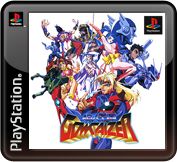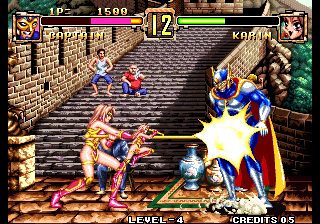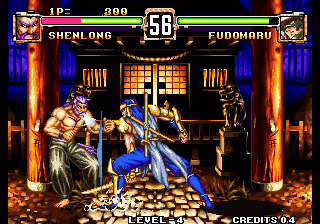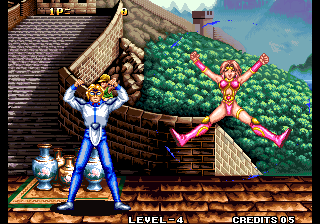Retro Replay Review
Gameplay
Voltage Fighter Gowcaizer offers a tight, one-on-one 2D fighting system that feels both familiar to SNK veterans and fresh for newcomers. The core combat revolves around a classic four-button layout—two punches, two kicks—augmented by Gowcaizer’s signature “Ability Steal” mechanic. After you defeat an opponent, you’re given the choice to absorb one of their special moves, adding a strategic layer: you must decide which ability best complements your playstyle, knowing you can only hold one at a time and any previous ability is lost when you switch.
(HEY YOU!! We hope you enjoy! We try not to run ads. So basically, this is a very expensive hobby running this site. Please consider joining us for updates, forums, and more. Network w/ us to make some cash or friends while retro gaming, and you can win some free retro games for posting. Okay, carry on 👍)
The pacing of matches is brisk, emphasizing rush-down tactics and well-timed counters. Special moves are charged with a meter that fills as you land strikes or take damage, and executing a special steal or an amplified mirror move can quickly turn the tide in a close bout. The mirror match bonus—where defeating your own replica amplifies your stolen move—rewards players who invest time memorizing combos and perfecting spacing. It’s a small twist that adds replay value, encouraging you to rematch foes to test different stolen abilities under pressure.
With a cast of ten unique characters, each fighter brings distinct normals, command throws, and supers to the table. From the lightning-fast strikes of Hayate to the zoning prowess of Janet, the variety keeps one-on-one tournaments engaging. The tournament-style progression has you face each opponent twice before unlocking the final boss, ensuring you learn each character’s quirks and can adapt your ability-steal choice accordingly. Versus mode also allows head-to-head play, making Voltage Fighter Gowcaizer a solid pick for retro fighting nights.
While the mechanics are easy to grasp, mastering the timing for ability switches and mirror amplifications requires practice. The learning curve strikes a sweet spot: accessible enough to pick up quickly, yet deep enough to reward those seeking advanced techniques. Whether you’re experimenting with different ability builds or hunting for that perfect combo string, the gameplay loop feels consistently satisfying.
Graphics
Voltage Fighter Gowcaizer’s visuals are a polished showcase of late-’90s arcade hardware. Character sprites are highly detailed, with crisp outlines and fluid animations that bring each fighter’s personality to life. Transformations into Gowcaizer or other powered-up forms are accompanied by striking color shifts and dynamic motion frames that still look impressive decades later. The art direction seamlessly blends anime-inspired designs with comic-book flair, creating a distinctive aesthetic that stands out among its peers.
Stage backgrounds are rich and varied, from the crumbling remnants of old Tokyo streets to the neon-lit halls of the National Belnar Institute. Parallax scrolling and layered backgrounds give each arena a sense of depth, while small environmental animations—flickering lights, swaying palm trees on the offshore island—add visual interest without distracting from the fight. Boss arenas feature more elaborate set pieces, raising the stakes as you near the end of the tournament.
Special move effects are colored with bold flashes and electric arcs, emphasizing impact without overwhelming the screen. Even on modern TVs or monitors, pixel clarity remains sharp, and the frame rate holds steady, ensuring inputs feel responsive. The user interface is clean: life bars, meter indicators, and ability icons are easy to read, leaving room for unobstructed views of the action.
Though not as graphically advanced as later 3D fighters, Gowcaizer’s sprite work has aged gracefully. Fans of pixel art will appreciate the commitment to detail and the hand-drawn charm that sets it apart from more generic fighters. On a CRT or through arcade-perfect emulation, the game’s visual presentation is a nostalgic highlight.
Story
Voltage Fighter Gowcaizer unfolds in a dystopian near-future where a 1999 earthquake devastates Tokyo, prompting the government to relocate to a man-made island. Years of peace on this new capital end abruptly in 2017, when tensions flare at the National Belnar Institute—the largest university on the island—upon the arrival of a mysterious new principal. This backdrop of political intrigue and social unrest sets the stage for the game’s real draw: the emergence of a hero.
Enter Isato Kaiza, an unassuming student who carries a mystical stone capable of manifesting incredible energy. As Kaiza, you transform into the superpowered warrior Gowcaizer, donning a helmet and armor to confront the forces of evil. While the narrative between fights is delivered in concise story screens and occasional animated intros, the core tale remains compelling: uncover the mastermind stirring violence, rally a diverse group of fighters, and restore harmony to your shattered homeland.
Each character’s personal motivations are woven into the tournament framework, from a veteran agent seeking redemption to a rival student harboring a secret grudge. These individual story threads deepen the experience, making each matchup feel more than just another fight. Rotating through opponents twice before the final confrontation allows bits of lore to unfold organically, rewarding players curious enough to pay attention to the plot snippets between battles.
While the storytelling is straightforward, it captures the spirit of a classic hero’s journey. The mix of sci-fi disaster aftermath, campus politics, and supernatural powers gives Voltage Fighter Gowcaizer a unique narrative identity, elevating it above more generic arcade fighters. For fans who enjoy a backdrop to justify their flashy battles, the game delivers a solid, if lean, storyline.
Overall Experience
Voltage Fighter Gowcaizer stands out as a hidden gem in SNK’s library, offering both fighting fans and retro enthusiasts a rewarding blend of solid mechanics and distinctive style. The ability-steal system injects strategy into every match, ensuring that no two playthroughs feel identical. Its manageable roster, while smaller than some contemporaries, focuses on quality and diversity, making each character memorable and fun to master.
The presentation—pixel art, animations, sound effects—still holds up today, especially when experienced on original arcade hardware or high-quality emulators. Though the story scenes are brief, they provide enough context to enrich your fights without slowing down the action. Whether you’re drawn by the lore of a post-quake Japan or simply seeking a polished 2D fighter, Voltage Fighter Gowcaizer delivers consistent thrills.
On the downside, some modern players may find the lack of extensive modes (no exhaustive training, survival, or online play in the original release) a limitation. However, the core versus mode and single-player tournament offer plenty of replayability, especially if you enjoy chasing high scores or perfecting character-specific strategies. For local gatherings or solo practice, the game’s balance and pace hit a sweet spot.
Ultimately, Voltage Fighter Gowcaizer is an engaging, well-crafted fighter that deserves a place in any arcade-collector’s lineup or retro gamer’s library. Its combination of unique mechanics, striking visuals, and a tight narrative framework make it a standout title—one that continues to captivate with every electrifying match. Whether you’re a longtime SNK admirer or a newcomer to 2D fighters, Gowcaizer offers a memorable journey into heroism, strategy, and pixel-powered combat.
 Retro Replay Retro Replay gaming reviews, news, emulation, geek stuff and more!
Retro Replay Retro Replay gaming reviews, news, emulation, geek stuff and more!









Reviews
There are no reviews yet.